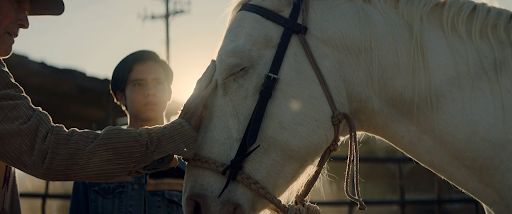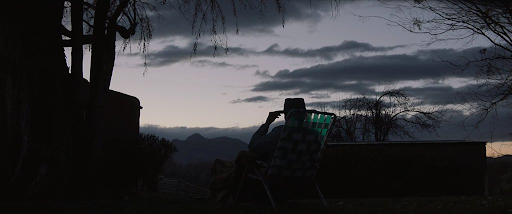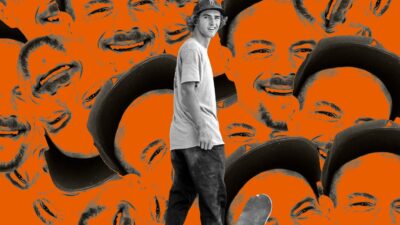Early on in CRY MACHO, director and star Clint Eastwood treats us to an image that has endured for decades in American culture: himself in a large cowboy hat, standing in the middle of an empty landscape stretching out endlessly, staring out at the sun setting over the horizon. Eastwood’s characters have all centered him as the archetypal Western hero, stretching back not just to the trilogy of Sergio Leone westerns that made him a star, but even further to his first big role in the TV series RAWHIDE as a young and headstrong cattle hand. Even the films that have placed Eastwood in more modern times—most notably the DIRTY HARRY series—imbue him with the qualities of the lone gunslinger, a man whose individual code of honor, tendency for violence, and bitter determination often pays a toll on himself and the lives of those closest to him. As the movie star transitioned into director beginning in the early 1970s, Eastwood paid close attention to his own status as an icon from the get-go. Even in his directorial debut PLAY MISTY FOR ME, Eastwood’s radio DJ character is introduced staring at a painting of himself. Especially as Clint Eastwood aged, the films starring him became even more thoughtful and critical of himself as a movie star, as a cowboy, as a womanizer, even as a filmmaker.
CRY MACHO carries on this tradition, albeit in a much lighter manner than previous works like UNFORGIVEN or GRAN TORINO. Based on an N. Richard Nash novel, the film follows an old ranch hand and former rodeo star Mike Milo (Eastwood) who is hired by a former boss to retrieve the man’s illegitimate teenage son from Mexico and bring him across the border to Texas. Along the way, Milo develops a bond with the son, Rafael (Eduardo Minett), and his pet rooster, Macho, while they are pursued by Mexican federales and Rafael’s abusive mother’s henchmen. Though the premise of CRY MACHO suggests a gritty neo-Western, the end product is an old man’s film, slowly progressing and abruptly halting at its own pace, using ellipses when its main character hides from the police or takes an afternoon nap, ultimately trying to prolong the inevitable end. Eastwood stubbornly refuses to conform his style of filmmaking to the present day; the result, like most of his films over the past 10 years, is both strangely out of time and deeply heartfelt.

At first glance, it would be easy to write CRY MACHO off as a filmmaker simply replaying the greatest hits of his career. The film’s loose narrative presents a variation on themes the director has already wrestled with for decades: his status as a star, his regrets that have accumulated and weighed on him over the years, becoming a father figure to a lost and lonely kid. The bond that Milo and Rafael build over the course of the movie is ultimately nothing we haven’t seen before in films like GRAN TORINO or HONKYTONK MAN. However, none of this really affects the quality of CRY MACHO. Eastwood’s interests as a filmmaker have been just as much about finding moments of quiet grace and humor amidst his engagement with larger themes of American masculinity, heroism, and individualism. Neither Eastwood nor newcomer Minett give world-class performances, but the two actors work quite well off each other, especially as their characters allow themselves to be more vulnerable. If the themes of CRY MACHO are familiar even to audiences unaccustomed to Eastwood’s body of work, then that only makes scenes like Milo teaching Rafael how to calm a bucking horse or Milo shedding a tear telling Rafael about his deceased wife and child all the more significant and affecting.
The look of CRY MACHO is quite different from the past several Eastwood-directed features. The gray digital sheen of movies like SULLY (2016) and RICHARD JEWELL (2019) was perfect in its own right for their depictions of individuals combating tightly controlled government bureaucracy and institutions. In CRY MACHO, those spaces are replaced with the small towns and sparse rocky hills of northern Mexico, and Eastwood accordingly invokes brighter colors and soaks many outdoor scenes with bright, almost blinding sunlight. His depiction of Mexico is perhaps simplified to an extent, but there is still more life here than most American films and TV, which typically apply a sickly yellow filter to the country’s setting. Eastwood, ever the humanist, sees the beauty in the small community Milo and Rafael hide in for a few weeks, particularly through the Mexican widow Marta (Natalia Traven) that he ends up falling in love with.

It’s impossible to watch or write about CRY MACHO without acknowledging Eastwood’s extreme age, least of all because it is a central factor of the film itself. It’s a testament to both Eastwood’s physical ability and his own ego that this movie exists at all, especially considering the role was originally meant for someone 20 or 30 years younger. If there is any true distinction between this film and his previous work, it is that it seems Eastwood has nothing new left to say about himself and his legacy, no more wisdom left that he can impart on his surrogate son. He quickly sheds his tough-guy exterior, and finds that he cannot protect himself from the cops and henchmen pursuing them, relying more on Rafael, and even Macho, to get them out of dangerous situations. As Milo mentions to Rafael when they look over a local deputy’s sick dog: “I can’t treat old.” All he can do is give Rafael a brief relapse of happiness and peace in between living with his cruel mother in Mexico City and meeting his estranged father in Texas, a time where he can learn how to ride a horse, care for animals, help others and accept help in turn. Maybe in these strange and uncertain times ahead, that can be enough.
















Comments